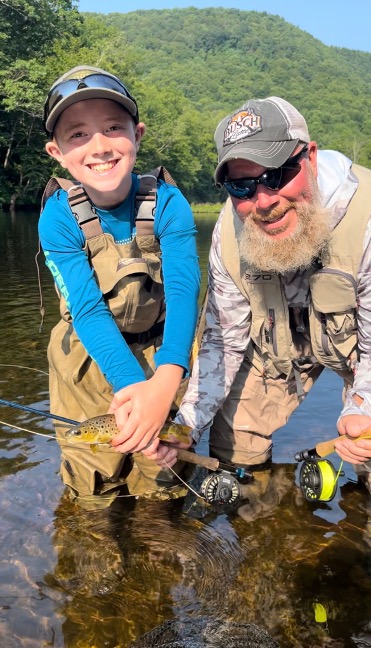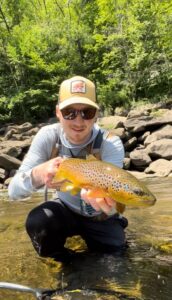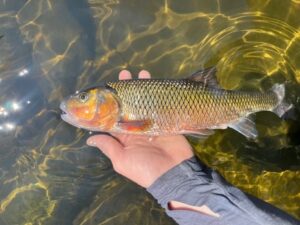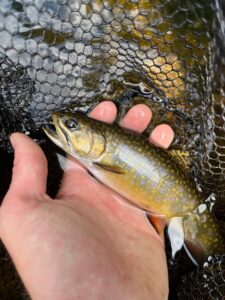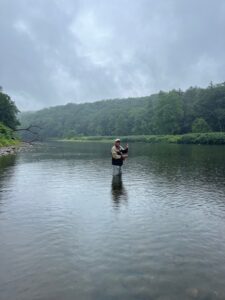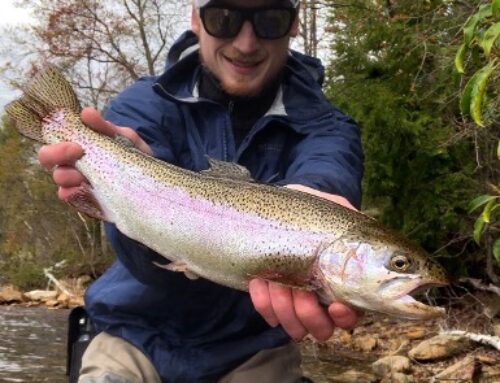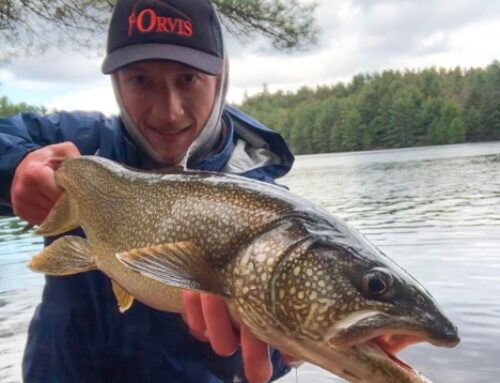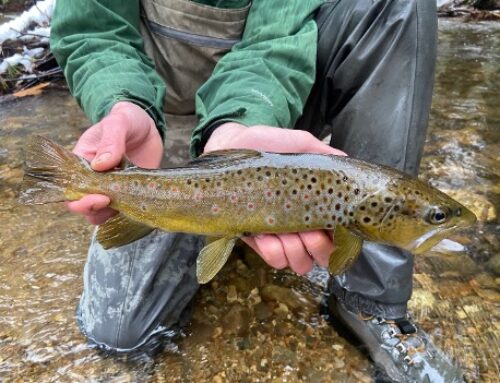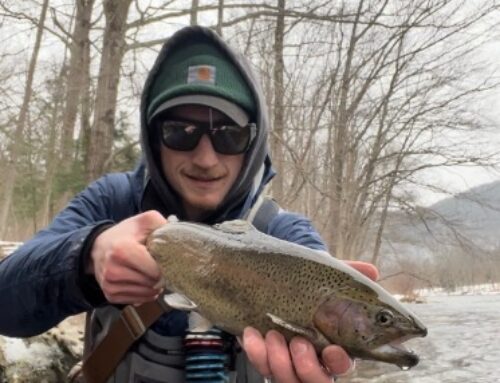It’s hard to believe it but we are already in the last half of summer–time flies while catching fish!
First off, the Deerfield is currently running very high due to anticipated heavy precipitation from Hurricane Debby. Flow is around 1200 CFS as this report is being written and it sounds like we can expect the same in the immediate future. Productive wade fishing can still be had at these flows but exercise caution when navigating the river. The three techniques that will perform best in the heavy water will be hopper droppers, nymphing (both indicator and contact) and streamer fishing. For both droppers and nymphing, it’s a good idea to use heavy flies that will punch down through fast currents; tungsten stonefly patterns, copper Johns and perhaps most effective, jig flies, are all smart options. For streamers, think more about line selection than flies. Sinking heads are a must in fast water in order to deliver presentations down to fish. With such high water, we recommend lines with fast sink rates—in store we like Cortland’s Streamer Sink Tip 15 or Airflo’s Streamer Max Long, the latter of which was developed alongside modern streamer master Kelly Galloup. Most importantly, know your limits while both wading and floating high water as situations can change faster than one can react.
Looking ahead towards more normal conditions, continue to be aware of water temperatures on the Deerfield. The high water should do a lot to cool the river down but late summer conditions can quickly heat things back up. When the river comes back down, the best time to hit the D will likely be either early or late when cooler air temperatures and low light have water temps at their lowest. Such timeframes generally host the most surface activity from fish too. As for stretches below Fife Brook, temperatures were running much too high for trout fishing before this interval of high water, so we’ll see what happens when things come back down. In the event that temperatures spike again, remember that many areas further down offer productive smallmouth fishing with some big, aggressive and native fallfish mixed in.
When flows level out again, it will likely be a good idea to focus attention on pockets and areas of faster, oxygen-rich water where many fish had been pushed into. In such areas, high floating terrestrial/stonefly imitations like a chubby Chernobyl or PMX are very effective on their own but even better with dropped nymphs and smaller dry flies. Look to target areas where the water is just deep enough to obscure your view of the bottom, but make sure to place preliminary casts in skinnier stuff before walking straight over it; plenty of fish had been holding in just a couple feet of water.
Aside from terrestrials, hatches on the Deerfield have been mixed and relatively sparse. There’s a modest amount of smaller caddis around (sizes 16-20) as well as some isonychia (“isos,” sizes 12-14), blue winged olives (sizes 16-18) and blue quills (sizes 18-20). Mayfly activity had been at its peak late in the day, but you might find some fish rising to them earlier on when water levels come back down. In terms of presentation, think about throwing all-purpose patterns like a (parachute) Adams, sparkle dun, klinkhammer etc. instead of getting overly committed to a specific hatch. As for caddis imitation, you can never go wrong with a good ol’ elk hair caddis, however, CDC caddis variants have been successful especially for finickier fish earlier in the day.
In a final note on the Deerfield, this is also a good time of year to think about mousing at night. Swinging and skating patterns like a master splinter or Mr. Hankey under darkness can offer one’s best chance at a trophy fish, especially for larger brown trout who hunt nocturnally for big meals. A floating line paired with a 6 or 7 weight rod will do nicely, and make sure to beef up leaders and tippet to 0x if not heavier. Beyond that, safety is an important consideration for anyone looking to try their hand at night mousing. First off, do not attempt to night fish while flows are still high as they are now. When things level out, we recommend fishing areas that you know well and/or have fished during daylight, avoid entering deep water and don’t attempt crossing the river. In terms of additional gear, a headlamp is essential to safely navigate the Deerfield’s rugged banks, and it’s also a good idea to carry a can of bear deterrent/spray as both bears and moose remain active at night. Attaching bells to one’s pack and/or playing music is also a good idea to avoid spooking one of the river’s larger residents.
As for the Millers and Westfield Rivers, the high water will hopefully cool things down a bit as temperatures had previously been high enough to all but count trout fishing out. For the moment, both will be difficult to manage owing to high flows but the Westfield will downtrend relatively quickly and we’ll see where water temperatures wind up. The Millers takes quite a bit longer to get back to ideal fishing levels. In any case, remember that both these rivers support robust smallmouth populations, particularly as you get further downstream. Fish are generally small, usually under 2 lbs., but are present in considerable numbers with a few larger fish here and there. Both streamers and topwater bugs had been performing well with fish feeding aggressively. For streamers, a 6 to 8 weight rod paired with a sinking head or even a floating line will do well. Streamer selection isn’t terribly important with such aggressive fish, but some options we like which are available in the shop are the finesse gamechanger, bank robber and deceiver, just to name a few. For topwater, a 6 to 8 weight rod with a floating line and relatively long leader is a good choice. Again, fly selection isn’t terribly important; in the shop we like a hard body popper, a slider, or a sneaky Pete, for example.
On the Swift River, fishing has been consistently good. The river was stocked again in early July with some pretty big fish in the mix, especially among the rainbow trout they dropped in. Sulphur activity has continued into August with fish getting on them usually a bit later in the day. The sulphurs coming off are around size 18 and are well imitated with parachutes, sparkle duns, and both CDC and poly-wing emergers. Small terrestrials like beetles and ants are also performing well, especially when cast in close proximity to tree overhangs and bank brush. Per usual, small midge patterns in sizes 26-30 will also get the job done with plenty of fish consistently rising to midges throughout a lion’s share of the day. In the latter case, consider dropping small midge imitations off more visible dries to make tracking them easier, and remember that lighter tippets (7-8x) are often necessary to minimize drag with such small presentations. Lastly for the Swift, this time of year is often highlighted by significant activity from big brook and brown trout, especially in the river’s deeper sections. These fish are highly educated and are often confined to difficult areas, but some dedicated exploration and bush whacking can yield pretty stunning results on the luckiest days.
As for the area’s small water—creeks and brooks—things had been bit touch and go with many creeks low and warm, so fingers crossed that this rain has done some good for both temps and flows. Rain tends to runoff quickly in small freestones with down trending intervals immediately following precipitation usually presenting solid fishing. Make sure to check temperatures with a thermometer. Remember, the magic number is 68°; anything there or warmer is too warm to safely catch & release trout. When you do find viable flows and temperatures, the usual mid-summer fare should perform well. Select high floating flies that can take the punishment of lots of eats and dropped nymphs which can be extremely productive both to slow rigs down a bit in fast pockets and punch down into areas that hold fish but might make it tough for them to rise.
On the warm water front, northern pike fishing has been productive with some very large fish coming to hand in the last couple weeks. Local pike fisheries can be difficult to access on foot—especially along the Connecticut River which is currently running unfishably high—but some dedicated exploration can produce excellent results. As mentioned, the CT River is tough going right now owing to massive rainfall higher in the watershed in Vermont; hopefully we’ll see it come back down into viable conditions in the coming weeks.
With a lot of fluctuation across the fishery at the moment you can never go wrong with some good old fashioned bass fishing. As mentioned above, the lower stretches of the Deerfield and Westfield, virtually all of the Millers, the Ware and other local rivers support robust populations of hard-fighting smallmouth which are not shy to eat a well-presented bug. Largemouth fishing in local still water can be very productive at this time of year too, especially during low light both early and late; all the better if you’ve got a kayak, canoe, or small outboard craft. Largemouth tend to be very structure oriented so focus attention on downed wood, grass lines, topwater growth like lily pads and the like. Both streamers and topwater bugs will fare well, and it’s a clever idea to throw a weedless selection in either case. Also make sure to beef up equipment when fishing around heavy structure to avoid breaking off or damaging rods while trying to pry a rotund bucket-mouth out of the slop.
Off the water, make sure to stop by our convenience kiosk located in the Zoar Outdoor retail shop on the north side of Rt. 2 in Charlemont if you haven’t already. We are in the final stages of scheduling some great events for September, including a new educational series called Expand Your Skills where we will offer classes on certain topics and techniques, like nymph fishing, streamer tactics, winter fishing and more. We also are planning a Trout Spey Day in September or October where we will offer a Spey casting clinic and have rods, reels and lines available to demo. On a river like the Deerfield, which can be hard to wade at higher flows, Spey casting allows you to get your fly out where it needs to be without having to wade far out into the fast moving water.
As always, thank you for your continued support from all of us at Deerfield Fly Shop and we wish you luck next time you’re on the water.


